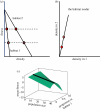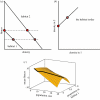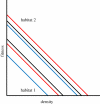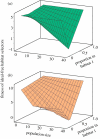Adaptation and habitat selection in the eco-evolutionary process
- PMID: 21613295
- PMCID: PMC3125633
- DOI: 10.1098/rspb.2011.0604
Adaptation and habitat selection in the eco-evolutionary process
Abstract
The struggle for existence occurs through the vital rates of population growth. This basic fact demonstrates the tight connection between ecology and evolution that defines the emerging field of eco-evolutionary dynamics. An effective synthesis of the interdependencies between ecology and evolution is grounded in six principles. The mechanics of evolution specifies the origin and rules governing traits and evolutionary strategies. Traits and evolutionary strategies achieve their selective value through their functional relationships with fitness. Function depends on the underlying structure of variation and the temporal, spatial and organizational scales of evolution. An understanding of how changes in traits and strategies occur requires conjoining ecological and evolutionary dynamics. Adaptation merges these five pillars to achieve a comprehensive understanding of ecological and evolutionary change. I demonstrate the value of this world-view with reference to the theory and practice of habitat selection. The theory allows us to assess evolutionarily stable strategies and states of habitat selection, and to draw the adaptive landscapes for habitat-selecting species. The landscapes can then be used to forecast future evolution under a variety of climate change and other scenarios.
Figures






References
-
- Hoffmann M., et al. 2010. The impact of conservation on the status of the World's vertebrates. Science 330, 1503–150910.1126/science.1194442 (doi:10.1126/science.1194442) - DOI - DOI - PubMed
-
- Polidoro B. A., et al. 2010. The loss of species: mangrove extinction risk and geographic areas of concern. PLoS ONE 5, e10095.10.1371/journal.pone.0010095 (doi:10.1371/journal.pone.0010095) - DOI - DOI - PMC - PubMed
-
- Rands M. R. W., et al. 2010. Biodiversity conservation: challenges beyond 2010. Science 329, 1298–130310.1126/science.1189138 (doi:10.1126/science.1189138) - DOI - DOI - PubMed
-
- Pereira H. M., et al. 2010. Scenarios for global biodiversity in the 21st century. Science 330, 1496–150110.1126/science.1196624 (doi:10.1126/science.1196624) - DOI - DOI - PubMed
-
- Pörtner H. O., Farrell A. P. 2008. Physiology and climate change. Science 322, 690–69210.1126/science.1163156 (doi:10.1126/science.1163156) - DOI - DOI - PubMed
Publication types
MeSH terms
LinkOut - more resources
Full Text Sources
Other Literature Sources
